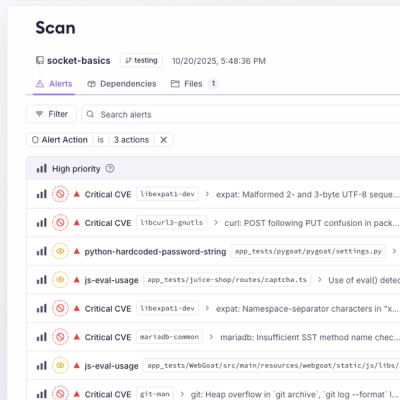
Product
Introducing Webhook Events for Pull Request Scans
Add real-time Socket webhook events to your workflows to automatically receive pull request scan results and security alerts in real time.
jmespath.js is a javascript implementation of JMESPath, which is a query language for JSON. It will take a JSON document and transform it into another JSON document through a JMESPath expression.
Using jmespath.js is really easy. There's a single function
you use, jmespath.search:
> var jmespath = require('jmespath');
> jmespath.search({foo: {bar: {baz: [0, 1, 2, 3, 4]}}}, "foo.bar.baz[2]")
2
In the example we gave the search function input data of
{foo: {bar: {baz: [0, 1, 2, 3, 4]}}} as well as the JMESPath
expression foo.bar.baz[2], and the search function evaluated
the expression against the input data to produce the result 2.
The JMESPath language can do a lot more than select an element from a list. Here are a few more examples:
> jmespath.search({foo: {bar: {baz: [0, 1, 2, 3, 4]}}}, "foo.bar")
{ baz: [ 0, 1, 2, 3, 4 ] }
> jmespath.search({"foo": [{"first": "a", "last": "b"},
{"first": "c", "last": "d"}]},
"foo[*].first")
[ 'a', 'c' ]
> jmespath.search({"foo": [{"age": 20}, {"age": 25},
{"age": 30}, {"age": 35},
{"age": 40}]},
"foo[?age > `30`]")
[ { age: 35 }, { age: 40 } ]
The example above only show a small amount of what a JMESPath expression can do. If you want to take a tour of the language, the best place to go is the JMESPath Tutorial.
One of the best things about JMESPath is that it is implemented in many different programming languages including python, ruby, php, lua, etc. To see a complete list of libraries, check out the JMESPath libraries page.
And finally, the full JMESPath specification can be found on the JMESPath site.
Lodash is a utility library that provides functions for common programming tasks, including data manipulation. While it doesn't use a query language like JMESPath, it offers a wide range of methods for manipulating objects and arrays, making it a versatile alternative.
JsonPath is another query language for JSON, similar to JMESPath. It allows you to extract parts of a JSON document using a query syntax. While both aim to simplify data extraction from JSON, their syntax and capabilities differ, with JMESPath generally offering a more expressive query language.
FAQs
JMESPath implementation in javascript
The npm package jmespath receives a total of 8,062,730 weekly downloads. As such, jmespath popularity was classified as popular.
We found that jmespath demonstrated a not healthy version release cadence and project activity because the last version was released a year ago. It has 1 open source maintainer collaborating on the project.
Did you know?

Socket for GitHub automatically highlights issues in each pull request and monitors the health of all your open source dependencies. Discover the contents of your packages and block harmful activity before you install or update your dependencies.

Product
Add real-time Socket webhook events to your workflows to automatically receive pull request scan results and security alerts in real time.

Research
The Socket Threat Research Team uncovered malicious NuGet packages typosquatting the popular Nethereum project to steal wallet keys.

Product
A single platform for static analysis, secrets detection, container scanning, and CVE checks—built on trusted open source tools, ready to run out of the box.